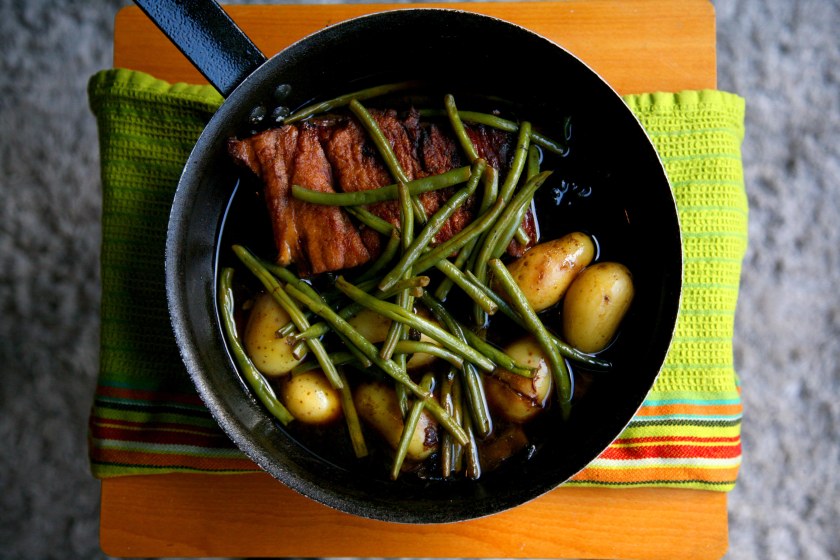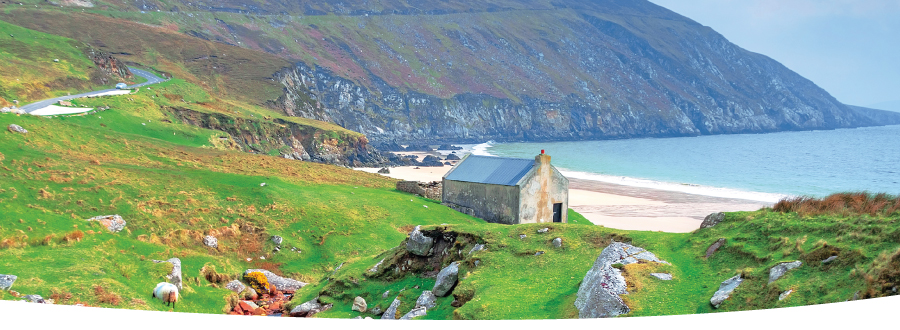
In New England’s November, when the windows are ice-cold in the mornings and the grass shimmers with frost, my mother starts to make her stew. This is a Dongbei dish, pork ribs, potatoes and green beans braised with soy, ginger, and star anise, the potatoes cooked until they are soft and the green beans until their surfaces wrinkle. The final touches are mung bean vermicelli, or fen si and a lavish glug of sesame oil.
In an earlier post about a news agent that serves Dongbei food, I mentioned lu rou, or Dongbei stewed meat, and how I simply don’t have the time to make it. Instead, I make this stew, which has similar flavours but more conveniently serves two or three people. Like lu rou and other stews, the flavour improves over time. Like lu rou, but unlike other stews, the vegetables become more delicious as the meat loses its savour. Every day, top this stew up with more green beans, potatoes, fen si and broth; the vegetables from the day before darken, soften, and provide a contrast. At the end you are eating vegetables in gravy and it is delicious. Fensi is optional – some people find the texture questionable – but for anyone with Dongbei blood, the fen si, which has turned tawny in its bath, is the best part.
At the backbone of the dish is star anise, or ba jiao, the prickly star shaped spice that is the unripe fruit of the Illirium verum tree. (Licorice, aniseed, fennel, and star anise are rich in anethole molecules, which is why these very these biologically unrelated roots, barks, bulbs, and seeds are virtually identical in flavor.)
For meat, pork ribs are customary, but I also like the richness of pork belly. If using ribs, see if your butcher will cut them in the “Chinese” way. (Instead of separating the ribs lengthwise, have him horizontally cut through a rack of ribs so that they are strips of ribs about two inches wide. However, normal style ribs will do.) For the pork belly, have the butcher remove the skin but leave the fat intact. I tend to find this braise makes the skin chewy, so I score it and make a separate crackling.
Smash the ginger slices, tear the scallions in half with your hands and crush them between your palms. Start all aromatics in cold oil (including star anise and my Americanised family’s additions of Sichuan peppercorn, bay leaves and rosemary) and as the oil comes up to temperature, the flavours will infuse. Brown your meat well. Stock, soy sauce, a spoonful of sugar, and a splash of Jerez sherry, which my family quite reasonably prefers to Chinese rice wine, go into the pot. When the meat is soft add your potatoes and beans, let it go until they are tender. Finish with a grind of pepper and dollop of sesame oil. No one ingredient better assuages my homesickness than sesame oil. And by sesame oil, I don’t mean the pale-hued organic stuff, but the heady, caramel colored “pure” ma you, and once you stir it into the stew, a nutty aroma will penetrate the room.
It’s an economical dish, and no fancy knife work is required. As you can probably tell, it isn’t exactly Michelin star fare. In China, Dongbei cuisine isn’t on the list of the eight influential Chinese cuisines, which include Sichuan, Canton, and Hunan. Many Chinese consider Dongbei people rustic and maybe a little backward. Even Dongbei words for things are bumpkin; “bao gu” for corn instead of “er mi;” “tu dou” (or dirt bean) for potato instead of the more elegant “di gua” (earth squash). The cold weather means a paucity of vegetables and a lot of turnips, cabbage and also potatoes, which were introduced by the Russians in the 19th century. In the rest of China, rice is the starch of choice, but in Dongbei, rice is expensive, and so they rely on corn, wheat, and potatoes. Dongbei people also love physical combat and drinking. Irish readers, punch yourselves if this sounds familiar.
My mother’s Dongbei stew has no name. I saw a photograph of something similar, which I traced to the Golden Palace restaurant in Flushing, Queens, and was uninspiringly named “stewed assorted vegetables w. braised pork.” A recipe for a Dongbei “luan dun” which literally translates into “messy stew,” calls for pork, star anise, and green beans, but also everything else in the vegetable crisper, baby corn, carrots, cabbage, snow peas.
My brother and I refer to it as that spare rib, green bean, potato and fen si thing.
My Irish boyfriend calls it Chinese Irish Stew.
***
Chinese Irish Stew (Serves 4)
3 ¼ inch slices of ginger, smashed with the blunt end of a knife
2 cloves garlic, smashed
5 scallions, twisted in half and bruised
4 star anise, broken into pieces
1 tsp Sichuan peppercorns, 2 bay leaves, one branch of rosemary, bruised. (optional)
Salt
1/3 cup vegetable oil like rapeseed
white pepper
¼ cup soy sauce
1/3 cup sherry
3 cups unsalted chicken stock (or can substitute water)
3 tbsp brown sugar
1 kilo pork ribs or pork belly, skin removed but fat intact, cut into two inch
pieces and skin scored and set aside. (See above.)
8 new potatoes, scrubbed, or 3 potatoes peeled and cut into thirds and then halved.
300 g. green beans, tops and tails chopped off.
100 g. fen si or mung bean vermicelli, preferably Long Kou (optional), rehydrated in boiling water for one minute and drained. ** see note.
fresh black pepper
Sesame oil to taste (3 tbsp)
** Long Kou fen si, or mung bean or cellophane vermicelli are the most reliable noodles on the market. They either come in a large packet, in which case you have to pull half the packet apart, OR they come in one packet of small bundles, in which case you need exactly two. Everyone tells you to let cellophane noodles to soak in water for a long time, but this will make them mushy. For me, if I am to cook them, I soak them for a minute, or pour boiling water over them while they sit in the strainer. You just want to soften them.
1. In a pan with a tight fitting lid or a Dutch oven, place 1/3 cup vegetable oil, place ginger, scallion, star anise, garlic, and other spices.
2. Bring the heat to medium, add a pinch of salt, and wait for the oil to begin to simmer and the spices to begin to smell aromatic(5 minutes).
3. Increase heat to medium high, add meat, and season generously with salt and white pepper. Brown the meat well on both sides. (10 minutes.)
4. Add stock, sherry, brown sugar, soy sauce, and increase the heat to high until everything is bubbling. Then reduce the heat to medium low and cover, and simmer for two hours, until the meat is soft when prodded with a fork.
5. Add potatoes and green beans, stir, and cover, and continue to simmer for 30 minutes. The potatoes should be tender to the fork. If they are not, continue to simmer.
6. (Optional) Add the drained fen si (mung bean vermicelli), stir and cover and simmer for fifteen minutes.
7. Taste and adjust seasoning. Add a lot of cracked pepper and a healthy glug of sesame oil.
8. Serve with rice and freshly chopped scallions if desired.





Luan Dun is one of my favorites when I lived in Dalian, in Liaoning province. The contentment of all food in there (potatoes, beans, pork, vermicelli) always made me thinking of how humble they name it using the word ‘Luan’.
LikeLiked by 1 person
That’s something I’ll be trying ASAP! Sounds absolutely delicious
LikeLiked by 1 person